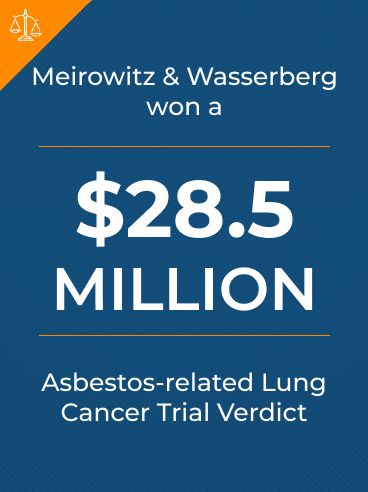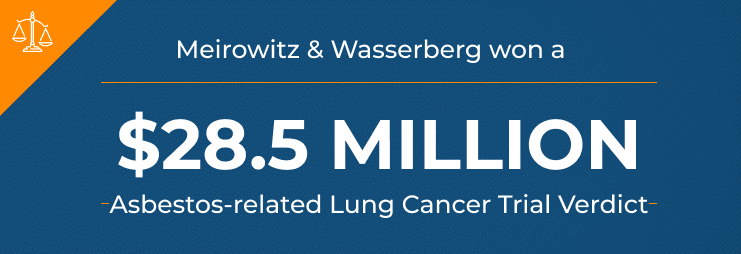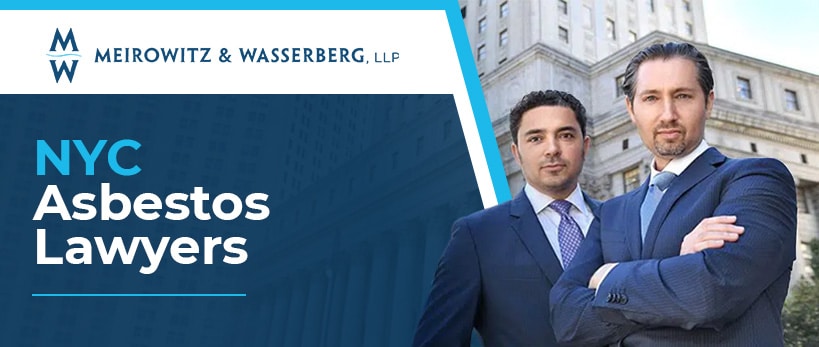NYC Asbestos Lawyer
Most Americans are at least somewhat familiar with asbestos and the dangers it presents, and the New York City asbestos lawyers at Meirowitz & Wasserberg, LLP, believe New Yorkers should be especially aware of the dangers of asbestos.
Our legal team may be able to help if you have been diagnosed with a serious disease after asbestos exposure.



Expertise
Mr. Wasserberg is proud to call himself a Trial Lawyer. He is often a featured speaker at industry summits and gatherings of the nation’s leading attorneys, from both sides of the bar. He is recognized by both his peers and his adversaries and is considered one of the nation’s premier mesothelioma and negligence attorneys
Content written by Dan Wasserberg

- Expertise
Mr. Wasserberg is proud to call himself a Trial Lawyer. He is often a featured speaker at industry summits and gatherings of the nation’s leading attorneys, from both sides of the bar. He is recognized by both his peers and his adversaries and is considered one of the nation’s premier mesothelioma and negligence attorneys
Experienced Mesothelioma Attorney

Daniel Wasserberg
“If you don’t know your client then you don’t know who you’re fighting for and you don’t know what you’re fighting for”
For decades, asbestos was the go-to fire retardant used in most construction work. Asbestos was also a main component in many building materials including textiles, cement compounds, roofing shingles, floor tiles, ceiling materials and car parts.
Over time, researchers exposed the glaring links between asbestos exposure and several types of lung diseases, including mesothelioma, lung cancer and pleural disease.
Quick Links
Understanding Asbestos
“Asbestos” actually refers to any of six naturally occurring fibrous minerals, including actinolite, tremolite, anthophyllite, chrysotile, crocidolite and amosite. Of these six minerals, chrysotile and amosite were the most commonly used. Asbestos fibers are microscopic yet very durable against fire and many other chemical reactions. Asbestos use declined rapidly in the late 1970s after it became apparent that asbestos exposure led to multiple health conditions, putting hundreds of thousands of lives at risk.
One of the most dangerous aspects of asbestos is that there is no safe exposure threshold. There is no safe type of asbestos and no level of exposure is safe at all. Anyone who has had any occupational contact with asbestos fibers is at serious risk for the many health problems asbestos can cause. In the early 1980s, workers in shipbuilding, power plant employees, construction workers, manufacturers and veterans all began reporting health complications that doctors linked to asbestos exposure.
Asbestos-Related Illnesses
The reason asbestos is so hazardous is also the reason it was so heavily sought after as a building material and fire retardant, its durability. Asbestos fibers are very durable and very small, so people exposed to asbestos commonly inhaled the fibers without realizing it. Over time, these fibers accumulated in the lungs and caused various problems.
Today, researchers have linked three major lung conditions to asbestos exposure:
Mesothelioma is a very aggressive form of cancer that affects both the lungs and the lining of the inner body cavity or mesothelium. Pleural mesothelioma is the most common form of the disease found in the lining of the lungs. Peritoneal mesothelioma affects the lining of the abdominal cavity, and pericardial mesothelioma attacks the lining of the heart.
Any type of mesothelioma has a dire prognosis, but treatment options are available. In addition to these types of mesothelioma, asbestos can also cause asbestosis, a degenerative and progressive respiratory condition.
Although nonmalignant in nature, asbestosis results from scar tissue forming on the visceral surface of the pleura (the lining of the lungs) and can signal the onset of mesothelioma.
How is Lung Cancer Different From Mesothelioma?
Both pleural mesothelioma and lung cancer involve the lungs, leading to similar symptoms. However, their origins differ: lung cancer develops within the lung tissue itself, while pleural mesothelioma affects the pleura, a protective membrane surrounding the lungs. The pleura is part of the mesothelium, a layer of tissue that lines various organs.
Lung cancer is one of the most common cancers in the United States, with the National Cancer Institute reporting over 236,700 new cases in 2022. In contrast, mesothelioma is rare, with fewer than 3,000 diagnoses annually. Approximately 70% of mesothelioma cases are pleural mesothelioma.
Asbestos Exposure & Lung Cancer
Asbestos exposure is a leading cause of lung cancer, particularly among individuals who lived or worked in high-risk industries like construction, shipbuilding, and manufacturing—industries historically prevalent in New York City. Asbestos fibers, when inhaled, can lodge in the lung tissue, causing inflammation and cellular damage that may lead to cancer. Decades of reliance on asbestos in NYC buildings, especially in insulation, flooring, and roofing materials, has left countless workers and residents unknowingly exposed.
Unlike smoking-related lung cancer, asbestos-related lung cancer often takes decades to develop after exposure, making early detection challenging. Symptoms can mimic other illnesses, leading to delayed diagnoses. Recognizing these symptoms and understanding the diagnostic process are critical for timely treatment and legal action.
At Meirowitz & Wasserberg, we understand the unique challenges faced by asbestos victims in New York City. If you or someone you love has been diagnosed with lung cancer linked to asbestos, our team is ready to help you seek justice and compensation. Below, we outline the common symptoms of asbestos-related lung cancer and the process for diagnosis of asbestos-related lung cancer, so you can take the next steps with confidence.
Symptoms of Asbestos-Related Lung Cancer
Lung cancer caused by asbestos exposure often shares symptoms with pleural mesothelioma and other respiratory conditions, making it difficult to identify without a thorough medical evaluation. According to the CDC, common symptoms of asbestos-related lung cancer include:
- Shortness of breath
- Persistent or painful cough
- Coughing up blood
- Chest pain or tightness
- Wheezing or difficulty breathing
- Fatigue or weakness
- Unexplained weight loss
These symptoms can overlap with those of other respiratory diseases, such as pneumonia, chronic obstructive pulmonary disease (COPD), or other types of cancer. If you have a history of asbestos exposure and experience any of these symptoms, it’s essential to seek medical attention promptly. Early detection can improve outcomes and is also critical for building a strong legal case.
Diagnosis of Asbestos-Related Lung Cancer
Diagnosing asbestos-related lung cancer requires a series of tests to pinpoint the cause of symptoms and create an effective treatment plan. Since asbestos-related conditions can take decades to manifest, timely and accurate testing is critical.
A chest X-ray is often the first diagnostic step, helping to rule out common conditions like pneumonia. While an X-ray may reveal abnormalities, such as tumors, it is not always conclusive. For more detailed imaging, a CT scan is typically performed. CT scans provide clearer views of the lungs and can help determine the tumor’s size, location, and potential spread.
To confirm lung cancer and identify its type, a biopsy is essential. During this procedure, doctors extract a small tissue sample from the tumor, which is analyzed in a laboratory to determine if it is cancerous and, if so, whether it is small cell lung cancer (SCLC) or non-small cell lung cancer (NSCLC).
Additional tests, like MRI or PET scans, may be needed to assess the cancer’s stage, ranging from 1 to 4 for NSCLC or “limited” versus “extensive” for SCLC. Early diagnosis improves treatment options and outcomes.
Asbestos In New York City
New York City has been the business and cultural capital of the world for many years, and due to its large population, the construction in the city is an ongoing challenge and expensive endeavor. Between 1999 and 2013, New York ranked fifth in the United States for mesothelioma and asbestosis deaths. In those years, 2,080 of the 2,406 deaths were due to mesothelioma, and asbestosis claimed 326 lives.
New York City is widely regarded as the birthplace of the asbestos industry. Due to the need for housing and construction in a highly congested area, fire protection has been a top priority for New York City builders for generations. Asbestos at first seemed like the perfect solution as it was readily available, affordable and very reliable in fire prevention. The Johns Manville Corporation started mining the materials for asbestos insulation in 1858 and asbestos use proliferated in the area for the better part of a century.
New York officials have enacted strict regulations to prevent new applications of asbestos and to prevent asbestos-related illnesses, but there are nearly 400 job sites, institutions and public buildings throughout the state of New York where asbestos exposure remains a serious issue. There are also concerns over naturally occurring asbestos, including the asbestos deposits near Gouverneur in Jefferson County. Prior to 1981, this area reported the highest mesothelioma rates in the United States.
Health Impact Of 9/11 On New Yorkers
After the World Trade Center attacks on September 11, 2001, the asbestos fallout resulting from the collapse included nearly 5,000 tons of MonoKote, a building material produced by W.R. Grace & Company, used in the construction of the Towers in the 1960s.
The 5,000 pounds of MonoKote spread across Lower Manhattan and Brooklyn following the attack, and residents in the area continue to report unusually high rates of respiratory disorders.
Deteriorating Infrastructure Problems
Many of the legislative measures taken to combat asbestos-related illness and death included careful inspection of remaining asbestos insulation. During the summer of 2007, old steam pipes insulated with asbestos burst and exposed those nearby to the asbestos fibers.
One of the pipes exploded in Manhattan and the other in downtown Boston. Older cities typically have a much harder time keeping pace with the need for infrastructure repairs, so some problems often linger until they become pressing concerns.
High-Risk Occupations For Asbestos
New York City has been a transportation hub since the 1800s, and construction in the city is nearly constant due to a rapidly growing population and deterioration of existing infrastructure. Construction is statistically the most dangerous industry in which to work, and construction jobs typically carry a higher risk of asbestos exposure than other occupations. Since many transportation centers and structures used asbestos in their construction, those working in these occupations also face a higher degree of risk.
The construction boom in the early 20th century led to many public schools, public housing units, offices, churches, sewage treatment plants, restaurants, bars and any other public building having asbestos in some form. As these older structures fell into disrepair, the workers charged with renovating, demolishing or repairing them came into contact with asbestos. Although asbestos falls under heavy regulation today, construction workers and transportation employees still face a higher degree of risk of asbestos exposure than other professions.
Another dangerous aspect of asbestos exposure is that mesothelioma, one of the most dangerous asbestos-caused illnesses, has a long latency period before it becomes actively harmful, sometimes waiting as long as 15 to 60 years before becoming a pressing health concern.
This can make it extremely difficult for people who contracted the illness years ago to secure compensation from the responsible parties. It’s also vital to recognize that even the relatives and loved ones of people exposed to asbestos are at risk. Asbestos fibers can cling to shoes, clothing, skin and hair, spreading to others at home. Some of the highest-risk occupations for asbestos exposure include:
- 9/11 first responders
- Aircraft mechanics
- Auto mechanics
- Bricklayers
- Boilermakers
- Carpenters
- Cement finishers
- Electricians
- Engineers
- Firefighters
- Foundry workers
- Machinists
- Mechanics
- Painters
- Pipefitters
- Plumbers
- Sheet metal workers
- Steamfitters
- Welders
This is not an exhaustive list — any number of tradesmen may encounter asbestos on the job, and it’s vital for these individuals to know their rights after a diagnosis of an asbestos-related illness.
What to Do If Exposed to Asbestos at Work
If you work or used to work in construction, clothing manufacture, or the automotive industry, you are especially at risk of harmful asbestos exposure. The steps you take immediately after realizing exposure are important.
Report to Your Employer
The day you realize you may have suffered asbestos exposure, report your suspicions to your employer. Your employer needs to know about the hazard if it still exists on the property. New York workers’ compensation laws also mandate that you notify your employer of any work-related injuries or illnesses within 30 days. Prompt reporting can fulfill your duties as an injured worker, and retain the possibility of filing a workers’ compensation claim.
Most workers do not realize they have experienced asbestos exposure until years after the event. Asbestos does not cause any immediate symptoms, even if particles have lodged in the lungs or other internal tissues. Instead, the particles will remain unnoticed in the body for years, until eventually causing a tumor or other serious health problem. You may not recognize asbestos exposure for 10 to 50 years after it happens. At this point, you can skip the step of reporting it to your employer and move straight to filing a claim.
Go to the Doctor
If you suspect past asbestos exposure, it’s crucial to consult a doctor and provide a detailed history. Early medical attention can help identify potential asbestos-related conditions, such as asbestosis or lung cancer. While no cure exists for mesothelioma—a terminal cancer linked to asbestos exposure—treatments are available to improve quality of life and extend life expectancy. For conditions like asbestosis, treatments can alleviate discomfort and reduce the risk of serious complications. Keeping copies of medical records, treatment plans, and related expenses is essential for both health management and legal purposes.
Determining whether lung cancer is asbestos-related involves evaluating specific factors. These include the presence of asbestosis, pleural plaques, or other changes in the pleura, as well as known asbestos exposure at least ten years prior, due to the latency period of asbestos-related diseases. The discovery of asbestos fibers in lung tissue or fluids can further support this determination, though the fibers are not always detectable. Even without direct evidence of asbestos fibers, other indicators can be sufficient to link lung cancer to asbestos exposure.
Establishing this connection is not only critical for medical care but also for exploring legal and financial options.
Be Aware of Signs of Mesothelioma
If you have reason to believe you could have asbestos particles in your system, learn the signs and symptoms of common related illnesses such as mesothelioma. Early diagnosis of a related disease could improve your odds of survival.
- Respiratory problems
- Pain in the chest or stomach
- Dry coughing or wheezing
- Unexplained weight loss
- Fever or night sweats
- Fatigue
- Muscle weakness
Schedule annual physical exams and explain that you are at risk of developing asbestos-related diseases. Routine X-rays and blood tests could help you come to a more timely diagnosis. Knowing the warning signs can expedite diagnosis and treatment.
Speak to a Lawyer
Workers’ compensation may seem like the clear solution to an asbestos issue if you experienced exposure at work. Yet this might not be the right choice for your claim. Your employer may no longer exist if exposure happened decades ago. Furthermore, a workers’ comp claim has benefit limits that may not be enough to fully compensate you for serious losses. Other legal options, such as a personal injury claim, could be more appropriate depending on the circumstances, and result in better compensation for damages.
- Past and future medical expenses
- Physical pain and suffering
- Emotional distress
- Mental anguish
- Lost quality of life
- Funeral and burial expenses
- Loss of consortium
- Lost wages
You or a loved one could be eligible to recover for all of these losses and more in the face of negligent asbestos exposure. The U.S. government has an asbestos trust fund in place to compensate victims whose employers cannot pay their damages. Do not write off your right to file a claim until you have spoken to an attorney. Discussing your case with an NYC mesothelioma attorney can reveal all your options for financial restitution in NYC.
Filing A Lawsuit For Asbestos-Related Illnesses
Although a lawsuit for an asbestos-related illness will likely fall under the purview of personal injury law, asbestos lawsuits are different than other personal injury lawsuits. Since the issue has been well-known for quite some time, asbestos lawsuits often involve the same attorneys, law firms and expert witnesses. Additionally, many asbestos-related lawsuits in New York City involve the same locations known for asbestos hazards.
Asbestos-related lawsuits are also different in that the courts have specialized “asbestos dockets” aimed at speeding up the litigation process. Asbestos-related illnesses are serious and progress very rapidly, so the court expedites legal proceedings for asbestos lawsuits so plaintiffs have a better chance of securing compensation fast enough for it to count.
Most asbestos cases can be filed with New York City Asbestos Litigation (NYCAL). divides asbestos claims into two sections: in extremis, for those suffering from lung cancer and mesothelioma, and first-in-first-out (FIFO) cases for individuals with nonsevere conditions and individuals who are deceased at the time of filing. Those cases that do not qualify for NYCAL can be filed Upstate. Regardless, anyone suffering from an asbestos-related illness should contact a reliable attorney as soon as possible to start the filing process.
Work With Meirowitz & Wasserberg, LLP
The team of New York City asbestos attorneys at Meirowitz & Wasserberg, LLP, understands how serious asbestos-related claims are, and we work closely with clients to fully represent every aspect of every case. An asbestos-related illness lawsuit for lung cancer or mesothelioma can help those suffering from these conditions recover compensation for medical expenses, pain and suffering, lost income, and other losses.
We offer free case evaluations to potential new clients, so reach out to us today to schedule a meeting with one of our attorneys. We’ll review the details of your situation and your medical report to assess what type of compensation you might secure through a lawsuit.
The dangers of asbestos have been well-known for decades, so negligent parties responsible for dangerous asbestos need to take responsibility for the damages they cause. Contact Meirowitz & Wasserberg, LLP, today to get started with your asbestos-related illness lawsuit today.

Our NYC Personal Injury Attorneys
AVAILABLE 24/7
Get Your Free Case ReviewNotable Results
$32,000,000+
Asbestos Exposure Verdict
$5,100,000+
Mesothelioma Settlement
$4,000,000+
Mesothelioma Settlement
Mesothelioma Related Cases
related Mesothelioma cases by Meirowitz & Wasserberg
Mesothelioma cases handled by Attorneys at Meirowitz & Wasserberg
Asbestos related cases by Meirowitz & Wasserberg

















